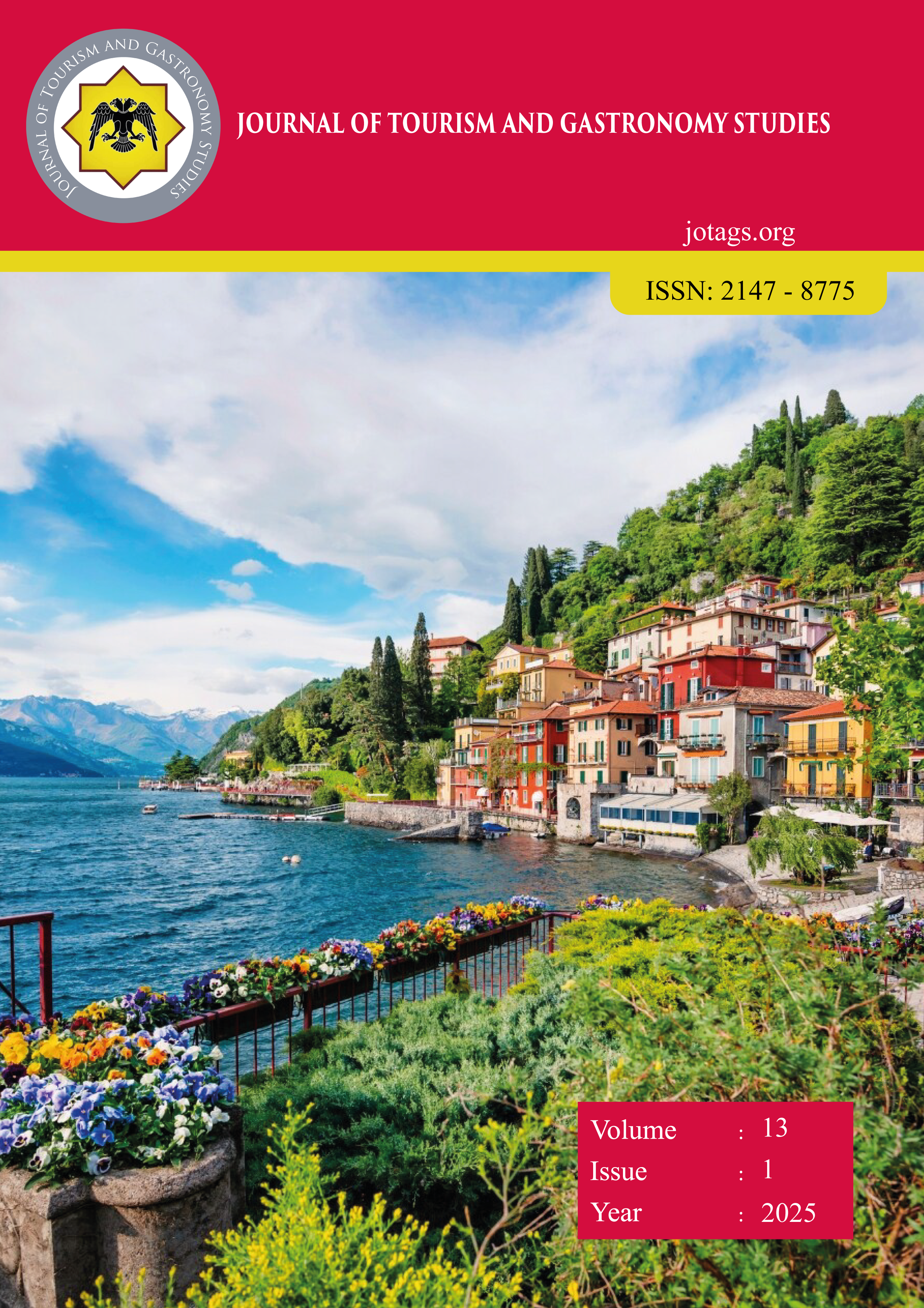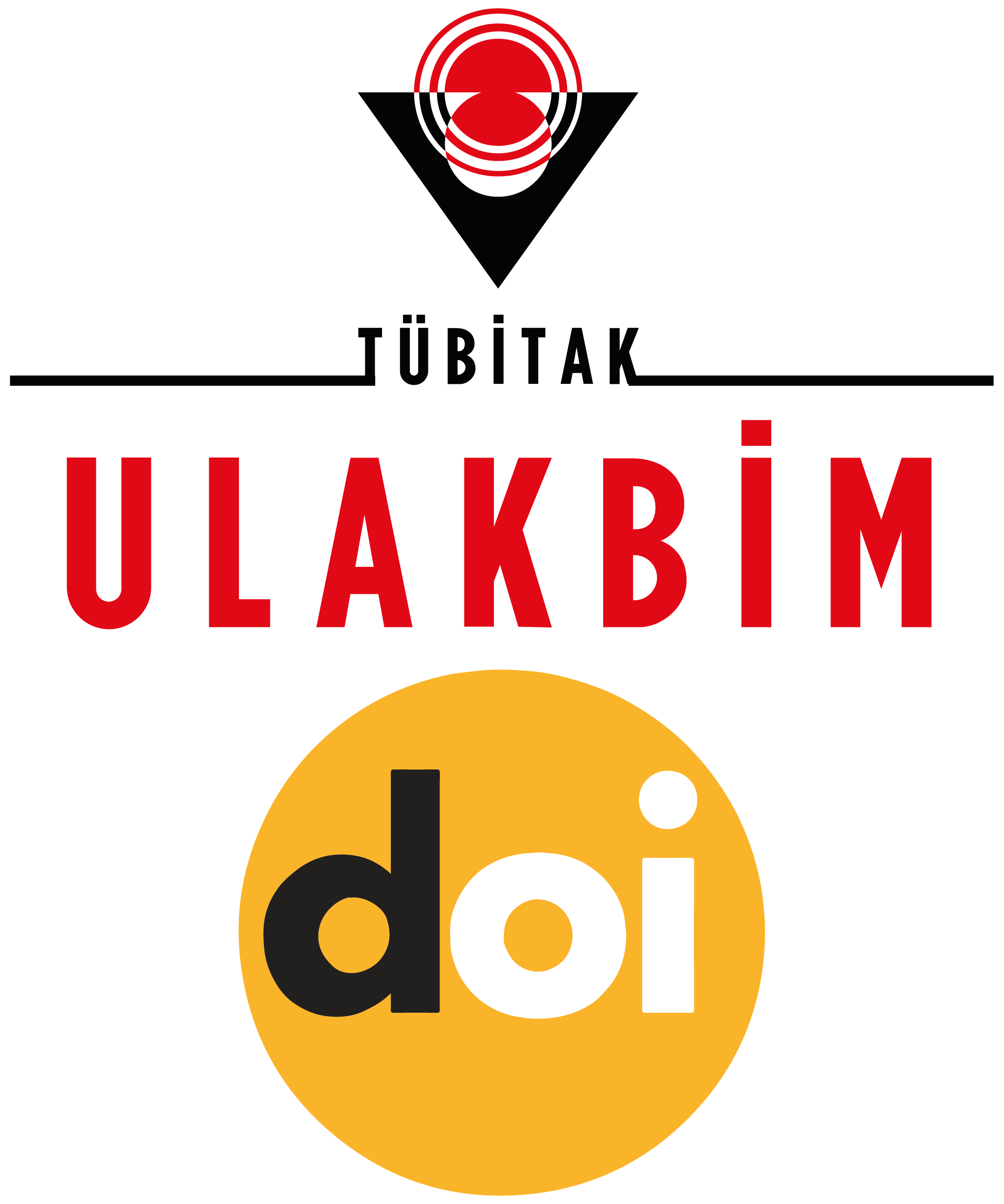Gastronomi ve Mutfak Sanatları Öğrencilerinin Mantar Kullanma Durumları ve Mantar Kullanımlarını Etkileyen Faktörler (The Mushroom Usage Status of The Students Studying in The Gastronomy and Culinary Arts Department and The Factors Affecting Their Mushroom Use)
DOI:
https://doi.org/10.21325/jotags.2025.1564Keywords:
Mushrooms, Wild edible mushrooms, GastronomyAbstract
Throughout human history, mushrooms have been used as a source of food and medicine. Due to their rich nutrient composition, taste, diversity, and widespread availability in nature, mushrooms are considered a valuable food source. Wild edible mushrooms and cultivated mushrooms have gained increased attention in recent years due to advancements in the field of gastronomy. The literature contains various studies that evaluate mushrooms from gastronomic, touristic, and economic perspectives. This study aims to determine the frequency of mushroom consumption and usage among students in the Gastronomy and Culinary Arts department and to identify the factors influencing this situation. The research employs a quantitative method, specifically the survey model. The data was collected with a structured questionnaire prepared by the researchers. Participants were included in the study through simple random sampling method. 449 questionnaires were collected. The data obtained from the questionnaires were analyzed and evaluated using statistical analysis with the SPSS 23 package program. The findings indicate that male participants consume and use mushrooms more frequently than female participants. Additionally, mushroom usage frequency increases with age, higher academic level, and increased sector experience. It was also found that individuals living in urban areas consume and use mushrooms more frequently compared to those living in rural areas. Mushrooms are most commonly consumed and used during the autumn and winter seasons. It has been concluded that mushrooms are primarily used in the preparation of pizza, main courses/mushroom sauté, and soups, and the most consumed and used mushroom type is cultured mushroom (Agaricus bisporus).
References
Aaronson, S. (2000). Fungi. In K. F. Kiple & K. C. Ornelas (Ed.), The Cambridge World History of Food (ss. 313–335). Cambridge, İngiltere: Cambridge University Press. doi:10.1017/CHOL9780521402149.033
Adanacıoğlu, N., Yıldız, Ü., Oğur E., Aykas, L., Tan, A. & Taylan, T. (2016). Türkiye makromantar genetik kaynakları I. Ege Bölgesi. Ege Tarımsal Araştırma Enstitüsü Dergisi, 26(1), 46-61.
Akkara, M., & Tosun, H. (2014). Funguslardan elde edilen endüstriyel ürünler. Gıda Teknolojileri Elektronik Dergisi, 9(2), 46-53.
Akman, M., & Baysal, A. (1984). Ege bölgesinde besin olarak kullanılan mantar türleri ve tüketim sıklığı üzerinde bir araştırma. Beslenme ve Diyet Dergisi, 13, 107–112.
Aktepe, B. P., & Aysan, Y. (2024). Türkiye’de yetiştirilen kültür mantarlarından (Agaricus bisporus) yumuşak çürüklük hastalığı etmeninin izolasyonu ve tanısı. Kadirli Uygulamalı Bilimler Fakültesi Dergisi, 4(2), 374–385.
Alemu F. (2015). Cultivation of shiitake mushroom (Lentinus edodes) on coffee husk at Dilla University, Ethiopia. Journal of Food and Nutrition Sciences, 3(2), 63-70. doi:10.11648/j.jfns.20150302.16
Arora, D. (1999). The way of the wild mushroom. The Magazine of the California Academy of Sciences, 52(4). https://researcharchive.calacademy.org/calwild/1999fall/stories/mushroom.html, E.T.:10.10.2024.
Barutçiyan, J. (2012). Türkiye’nin mantarları-1. İstanbul, Türkiye: Oğlak Yayıncılık.
Bayrak, E. & Cebirbay, M. (2018, Kasım 28-30). Türkiye'de yenilebilir mantarların besin değerleri [Bildiri sunumu]. International Conference on Food, Nutrition and Dietetics, Gastronomy Research. Antalya, Türkiye.
Boa, E. (2004). Wild edible fungi: a global overview of their use and ımportance to people [e-book]. https://www.researchgate.net/publication/284221866_Wild_Edible_Fungi_A_Global_Overview_of_Their_Use_and_Importance_to_People
Bulam S, Üstün N., & Pekşen A. (2018). The most popular edible wild mushrooms in Vezirköprü district of Samsun province. Turkish Journal of Agriculture-Food Science and Technology, 6(2), 189-194. doi:10.24925/turjaf.v6i2.189-194.1547
Chang, S. T., & Miles, P. G. (1992). Mushroom biology: a new discipline. Mycologist, 6(2), 64–65. doi:10.1016/S0269-915X(09)80449-7
Cochran, K.W. (1978). Medical Effects. In S. T. Chang, & W. A. Hayes (Ed.), The biology and cultivation of edible mushrooms (ss. 169-181). New York, ABD: Academic Press.
Crisan, E. V. & Sands, A. (1978). Nutritional Value. In S. T. Chang and W. A. Hayes (Ed.), The biology and cultivation of edible mushrooms (ss. 81-137). New York, ABD: Academic Press.
Demir, H. (2010). Sağlığınız için mantar tüketin?. Hasad Gıda, 14-15.
Demirel, H., & Ayyıldız, S. (2017). Mutfak kültürü ve değişimi; Giresun ili örneği. Journal of Tourism and Gastronomy Studies, 5(4), 280-298.
Duman, G., & Sarper, F. (2023). Fonksiyonel bir gıda olarak yenilebilir mantarlar: mutfak şeflerinin kullanma ve bilgi durumlarının incelenmesi. Aydın Gastronomy, 7(1), 43-56. doi: 10.17932/IAU.GASTRONOMY.2017.016/gastronomy_v07i1003
Erdem, Ö., Bayram, F., Çiftçi, B., & Kemer, A. K. (2018). Mutfak şeflerinin yöresel mantarları tanıma ve kullanım durumlarına ilişkin keşifsel bir araştırma. Journal of Tourism & Gastronomy Studies, 6 (Özel Sayı 3), 225-239. doi: 10.21325/jotags.2018.250
Eren, E., & Pekşen, A. (2016). Türkiye ‘de kültür mantarı sektörünün durumu ve geleceğine bakış. Turkish Journal of Agriculture-Food Science and Technology, 4(3), 189-196. doi: 10.24925/turjaf.v4i3.189-196.595
Eren, E., & Pekşen, A. (2019). Türkiye ’de kültür mantarı üretimi ve teknolojik gelişmeler. Mantar Dergisi, 10, 225–233. doi:10.30708.mantar.649141
Eren R., Süren T., & Kızıleli M. (2017). Gastronomik açıdan Türkiye’de yenilebilir yabani mantarlar üzerine kavramsal bir değerlendirme. Turizm Akademik Dergisi, 4(2), 77-89.
Feeney, M. J., Myrdal Miller, A. & Roupas, P. (2014). Mushrooms-biologically distinct and nutritionally unique: exploring a ‘‘Third Food Kingdom’’. Nutrition Today, 49(6), 301-307. doi: 10.1097/NT.0000000000000063
Fieldhouse, P. (1995). Biocultural perspectives on nutrition. In Food and Nutrition: Customs and Culture (ss. 1-29). Cheltenham, UK: Nelson Thornes
Gül, Ş., Çarbuğa, Ü., & Kocaman, E. M. (2018). Ordu ili mutfak kültüründe mantarlar. In E. Özkul, B. Bilgili & S. Uca (Ed.), Kocaeli Ugtak Bildiri Kitapçığı. International Gastronomy Tourism Studies Congress, Kocaeli, Turkiye. https://ugtak.org/admin/ckeditor_files/files/Kocaeli%20UGTAK%20Bildiri%20Kitab%C4%B1.pdf
Gürgen, A., Değirmenci, A., & Yıldız, S. (2019). Bazı yabani ve kültür mantarı turşularının duyusal analizleri. Journal of the Institute of Science and Technology, 9(1), 302-309. doi:10.21597/jist.463601
Laundon, J. R. (1984). Ainsworth & Bisby’s Dictionary of the Fungi. The Lichenologist, 16(2), 207–208. doi:10.1017/S0024282984000360
Işkın, M. & Sarıışık, M. (2017). Öğrencilerin besin tüketim alışkanlıkları üzerine bir araştırma. Türk Turizm Araştırmaları Dergisi, 1(1), 33-42. doi: 10.26677/tutad.2017.2
Kalac, P. (2016). Minor constituents. In Kalac, P. (Ed.), Edible mushrooms chemical composition and nutritional value (ss. 71-136). New York, ABD: Academic Press. doi:10.1016/B978-0-12-804455-1.00003-5
Karakaş, H. & Törnük, F. (2016). Geleneksel gıdaların okul çağı çocuklarının beslenmesindeki rolü üzerine bir araştırma. Cumhuriyet Üniversitesi Fen Bilimleri Dergisi, 37(3), 292-302. doi: 10.17776/csj.59128
Kendrick, B. (2017). Kingdoms, Classification, Nomenclature, and Biodiversity. In The fifth kingdom (ss. 5-56). Waterloo, Canada: Mycologue Publications.
Kibar, B. (2015). Iğdır ili mantar tüketim alışkanlıklarının belirlenmesi. Iğdır Üniversitesi Fen Bilimleri Enstitüsü Dergisi, 5(4), 9-16.
Kirk, P. M., Cannon, P. F., Minter, D. W., & Stalpers, J. A. (2008). Ainsworth & Bisby’s Dictionary of the Fungi (10th ed.). Wallingford, USA: CABI Publishing.
Küçükyaman, M. A., Demir, Ş. Ş., & Bulgan, G. (2018). Mutfak şeflerinin yöresel ürünlere ilgisi: Isparta örneği. Güncel Turizm Araştırmaları Dergisi, 2(1), 86-103.
Latiff, L. A., Daran, A. B. M., & Mohamed, A. B. (1996). Relative distribution of minerals in the pileus and stalk of some selected edible mushrooms. Food Chemistry, 56(2), 115-121. doi:10.1016/0308-8146(95)00129-8
Mantoux, A. (Ed.). (2007). Le Grande Larousseggastronomique. Paris, France: Larousse.
Manzi, P., Aguzzi, A., & Pizzoferrato, L. (2001). Nutritional value of mushrooms widely consumed in Italy. Food Chemistry, 73(3), 321–325. doi:10.1016/s0308-8146(00)00304-6
Manzi, P., Gambelli, L., Marconi, S., Vivanti, V., & Pizzoferrato, L. (1999). Nutrients in edible mushrooms: An interspecies comparative study. Food Chemistry, 65(4), 477-482. doi:10.1016/s0308-8146(98)00212-x
Memiş Kocaman, E. (2021). Tokat çemeninin tüketimi üzerine bir araştırma. V. Uluslararası Gastronomi Turizmi Araştırmaları Kongresi (UGTAK) Bildiri Kitabı, Sakarya, Türkiye, 35-44. https://ugtak.org/admin/ckeditor_files/files/Sakarya%20Ugtak%20bildiri%20kitab%C4%B1.pdf
Memiş Kocaman, E., Çobantürk, M. & Akman, T. (2019). Kendiliğinden yetişen otların tüketiminde yaşanılan yerin etkisi. IV. Uluslararası Gastronomi Turizmi Araştırmaları Kongresi (UGTAK) Bildiri Kitabı, Nevşehir, Türkiye, 337-341. https://ugtak.org/admin/ckeditor_files/files/Nevs%CC%A7ehir%20UGTAKProceedingsBook.pdf
Memiş Kocaman, E., & Sormaz, Ü. (2023). Fonksiyonel bir besin olan kuşburnu meyvesinin Türkiye’de tüketimi. Safran Kültür ve Turizm Araştırmaları Dergisi, 6(3), 435-453.
Sayılı Odun Dışı Orman Ürünlerinin Envanter ve Planlaması ile Üretim ve Satış Esasları 2016 (2016, Haziran 06). https://www.ogm.gov.tr/tr/e-kutuphane-sitesi/mevzuat-sitesi/Tebligler/302%20say%C4%B1l%C4%B1%20odun%20d%C4%B1%C5%9F%C4%B1%20orman%20%C3%BCr%C3%BCnlerinin%20envanter%20ve%20planlanmas%C4%B1%20ile%20%C3%BCretim%20ve%20sat%C4%B1%C5%9F%20esaslar%C4%B1%20Tebli%C4%9Fi.pdf. E.T.: 21.08.2024.
Öztürk, A. & Çopur, Ö. U. (2009). Mantar bileşenlerinin teröpatik etkileri. Bahçe, 38(1), 19-24.
Öztürk, M., Soylu M. K., Temel M., Pezikoğlu F., & Mısır Bilen G. (2019). Türkiye’nin dünya mantar dış ticaretindeki yeri. Uluslararası Anadolu Ziraat Mühendisliği Bilimleri Dergisi, Özel Sayı 1, 102–107.
Paksoy, M. & Aksüt, M. (2012, Ekim 18-20). Mantar tüketimi ve tüketim alışkanlıklarının belirlenmesi: Kahramanmaraş ili örneği [Bildiri sunumu]. IX. Türkiye Yemeklik Mantar Kongresi, Denizli, Türkiye.
Patel, S. & Goyal, A. (2012). Recent developments in mushrooms as anti-cancer therapeutics: A review. 3 Biotech, 2(1), 1–15. doi:10.1007/s13205-011-0036-2
Paul, B. D. & Snyder, S. H. (2010). The unusual amino acid l-ergothioneine is a physiologic cytoprotectant. Cell Death Differ, 17(7), 1134-1140. doi: 10.1038/cdd.2009.163
Peksen, A. & Kaplan, M. (2016). Ordu ilinin ekonomik öneme sahip yenilebilen doğa mantarları. Akademik Ziraat Dergisi, 6, 335-342.
Roncero-Ramos, I., Delgado-Andrade, C. (2017). The beneficial role of edible mushrooms in human health. Current Opinion in Food Science, 14, 122-128. doi: 10.1016/j.cofs.2017.04.002
Salehi, F. (2019). Characterization of different mushrooms powder and its application in bakery products: A review. International Journal of Food Properties, 22(1), 1375–1385. doi: 10.1080/10942912.2019.1650765
Sarıkürkçü, C., Tepe, B., & Yamaç, M. (2008). Evaluation of the antioxidant activity of four edible mushrooms from the central Anatolia, Eskisehir - Turkey. Bioresource Technology, 99(14), 6651-6655. doi: 10.1016/j.biortech.2007.11.062
Singh, R. P., & Mishra, K. K. (2008). Mushroom Cultivation. Mushroom Research and Training, 1-25.
Singdevsachan, S. K., Auroshree, P., Mishra, J., Baliyarsingh, B., Tayung, K., & Hrudaynath, T. (2016). Mushroom polysaccharides as potential prebiotics with their antitumor and ımmunomodulating properties: A review. Bioact Carbohydrates Diet Fibre, 7(1), 1–14. doi.10.1016/j.bcdf.2015.11.001
Sissons J., Davila M., & Du X. (2022). Sautéing and roasting effect on free amino acid profiles in portobello and shiitake mushrooms, and the effect of mushroom- and cooking-related volatile aroma compounds on meaty flavor enhancement. International Journal of Gastronomy and Food Science, 28, 1-12. doi:10.1016/j.ijgfs.2022.100550
Şimşek, A. & Önek, Ü. M. (2021). Yenilebilir mantar tüketimi ve yemekleri üzerine bir inceleme: Kastamonu örneği. Türk Mutfak Kültürü Araştırmaları Dergisi, 1(1), 21-30.
TDK Güncel Türkçe Sözlük (2022). E.T.: 09.06.2024. https://sozluk.gov.tr/?ara=mantar
Türkoğlu, A. (2015). Yeraltındaki Gizli Hazine: Trüf Mantarları. Orman ve Su Bakanlığı, Orman Genel Müdürlüğü Yayını. http://aturkoglu.com/files/YER%20ALTINDAK%C4%B0%20G%C4%B0ZL%C4%B0%20HAZ%C4%B0NE%20%20%C3%B6zet.pdf
USDA. (2024). FoodData Central, Pizza. https://fdc.nal.usda.gov/fdc-app.html#/food-search?query=pizza&type=Survey%20(FNDDS), E.T.: 21.08.2024.
Wani, B.A., Bodha, R.H., & Wani, A.H. (2010). Nutritional and medicinal importance of mushrooms. Journal of Medicinal Plants Research, 4(24), 2598-2604. doi:10.5897/JMPR09.565
Valverde, M. E., Hernández-Pérez, T., & Paredes-López, O. (2015). Edible mushrooms: Improving human health and promoting quality life. International Journal of Microbiology, 1-14. doi:10.1155/2015/376387
Yılmaz, A., Yıldız, S., Yıldırım, İ., & Aydın, A. (2016). Trabzon’da mantar tüketimi ve tüketim alışkanlıklarının belirlenmesi. Mantar Dergisi, 7(2), 135-142. doi:10.15318/Fungus.2016222681
Yücenur, N. G., Şenkan, Ç., Kara, G. N., & Türker, Ö. (2019). Birleştirilmiş Swara-Copras yaklaşımını kullanarak trüf mantarı yetiştirilmesi için bölge seçimi. Erzincan University Journal of Science and Technology, 12(3), 1232-1253. doi:10.18185/erzifbed.536800
Downloads
Published
How to Cite
Issue
Section
License
Copyright (c) 2025 Journal of Tourism & Gastronomy Studies

This work is licensed under a Creative Commons Attribution-NonCommercial 4.0 International License.








